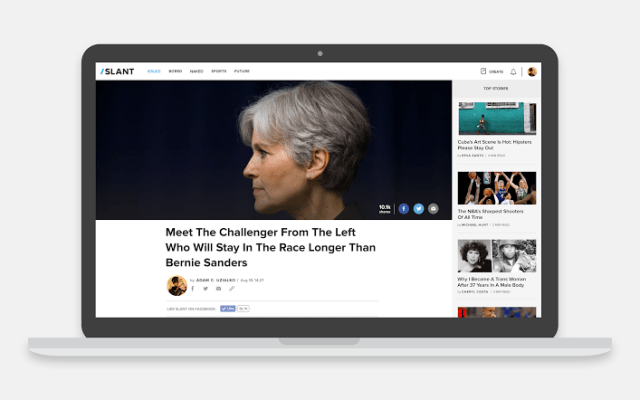Here’s an impressive claim: Slant says that it’s creating “America’s most diverse newsroom.”
The structure of that newsroom isn’t exactly traditional — in fact, starting today, Slant is open to anyone who wants to write an article for the site. This might sound like a recipe for crap content, but Editorial Director Amanda Gutterman suggested that Slant combines the best of the crowdsourced and professional approaches.
Gutterman already has plenty of experience with contributed content, having worked as associate editor at The Huffington Post (which, like TechCrunch, is owned by AOL/Verizon). She said that normally, if you write something for “the massive content farms and big platforms where you can immediately publish anything,” there are two big drawbacks. First, there’s “no editing, no optimizing.” Second, the publishing platform makes all the money.
With Slant, on the other hand, the writer works with a professional editor who helps them write a catchy headline, find an image, promote the story on social media, think about SEO — basically, Gutterman said their job is to bring in “all of the skills that one builds up as a digital journalist.” And the writer makes money, too, specifically 70 percent of the revenue that their article brings in.
The thing is, a good editor doesn’t just help you package your story to get more traffic. They can also help you figure out what a story is missing, point out the weaknesses in your argument and so on. Asked whether Slant editors can also get involved in a more substantive way, Gutterman said they will help with factual accuracy, but she added, “We don’t want to be changing the intention of the writer.”
Slant has been in beta testing with a limited set of writers (many of them coming from universities around New York City) for the past two months. Gutterman said she’s already proud of the stories the site has published, like a tribute to murdered journalist Alison Parker written by one of her former classmates, and a profile of Green Party presidential candidate Jill Stein. And that initial group of contributors is already pretty diverse — for one thing, she estimated that more than half of them are nonwhite.
“I’m really proud of the diversity and being able to give voice to people who didn’t necessarily have another place to go to say what they wanted to say,” she said.
If Slant’s contributor base continues to expand, it could be challenging to keep up that editing process. CEO and Publisher Aviram Elad emphasized that “everyone” will get the editorial treatment, but Gutterman noted that as more stories come in, editors will probably spend more time on some of them.
“We’re going to have to redistribute editorial time and focus on stories that we think are important,” she said.
Hopefully, the argument for newsroom diversity is self-evident, but in case it isn’t: Gutterman pointed to recent coverage of “police brutality against African Americans.” People from many different backgrounds could have something worthwhile to say about it, but if you’re African American yourself, “that experience enriches and adds to their ability to tell that kind of story.” She argued that among millennials in particular, “People care about who is telling the story.”
